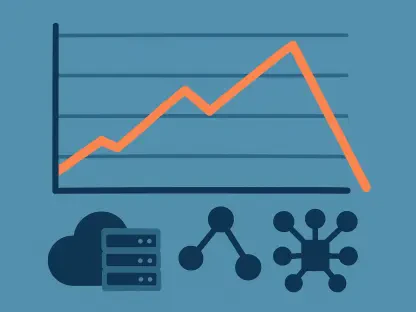In the rapidly shifting landscape of cloud computing, the second quarter of the year has unveiled a fierce battle among the leading U.S. hyperscale cloud providers, with Microsoft Azure, Amazon Web Services (AWS), and Google Cloud Platform (GCP) vying for dominance in a market fueled by artificial intelligence (AI) demand. The stakes have never been higher as these giants pour unprecedented resources into infrastructure, with a combined annual capital expenditure (CapEx) projected at a staggering $240 billion. This financial commitment underscores a high-stakes race to build capacity for future returns, driven primarily by AI workloads that are reshaping enterprise technology spending. However, supply constraints, divergent growth rates, and shifting market shares add layers of complexity to this competitive saga. As the cloud infrastructure market stands at a critical juncture, the performance of each provider reveals unique strengths and challenges that could redefine the industry’s hierarchy in the coming years.
This intense competition is not just about raw numbers but also about strategic positioning, with each player vying for dominance in the cloud computing space. Azure has emerged as a frontrunner with AI-driven momentum, while AWS grapples with supply chain hurdles despite its revenue leadership. Google Cloud, often underestimated, is quietly carving out a stronger foothold with steady execution. Financial metrics paint a vivid picture, showing Azure’s 39% year-over-year (y/y) growth outpacing AWS’s 17.5%, with Google Cloud’s core services nearing 40%. These disparities are reshaping market dynamics, while profitability trends and massive investments highlight the delicate balance between growth and sustainability. As external challenges like power shortages and silicon constraints loom large, the path forward through 2025 and beyond remains fraught with uncertainty, yet brimming with potential.
AI as the Growth Engine
Harnessing AI for Competitive Edge
The transformative power of AI is undeniably at the heart of the cloud computing surge, with Microsoft Azure leveraging its strategic partnership with OpenAI to achieve remarkable growth in the second quarter. Azure’s integration with technologies like ChatGPT has propelled its revenue, contributing an estimated $3 billion in AI-driven earnings during the period. This synergy has fueled a robust 39% year-over-year growth rate, distinguishing Azure from its competitors and positioning it as a leader in the AI workload space. The ability to capitalize on AI inference workloads has not only boosted financial performance but also strengthened Azure’s remaining performance obligation (RPO) to $368 billion, signaling a long runway for sustained expansion. This momentum is further supported by software efficiencies, such as a 90% increase in tokens per GPU year-over-year, which help offset the margin pressures of scaling AI infrastructure.
Beyond raw growth, Azure’s AI strategy is reshaping customer expectations and driving enterprise adoption at an accelerated pace, making it a leader in the industry. The seamless incorporation of advanced models into its platform has made Azure a go-to choice for businesses looking to integrate AI into their operations. However, this reliance on external partnerships introduces dependencies that could pose risks if competitive dynamics shift or if new models fail to deliver expected results. Additionally, the lack of transparency around Azure-specific operating margins raises questions about the long-term profitability of this AI-centric approach. As supply constraints are projected to persist into mid-2025, the challenge lies in maintaining this growth trajectory while addressing capacity limitations that could defer demand.
Rival Strategies in AI Development
AWS and Google Cloud are not far behind in the AI race, each deploying substantial resources to capture a share of this burgeoning market despite trailing Azure in headline growth. AWS has invested heavily in its proprietary Trainium2 chips, aiming to enhance its AI capabilities and support a diverse ecosystem that includes platforms like Bedrock and AgentCore. With AI services contributing around $2 billion in the second quarter, AWS demonstrates a commitment to innovation, backed by a backlog of $195 billion that indicates strong future demand. This focus on a comprehensive AI stack offers customers flexibility and choice, positioning AWS as a formidable player even as its overall growth rate of 17.5% year-over-year draws scrutiny compared to its rivals.
Meanwhile, Google Cloud is leveraging its Tensor Processing Units (TPUs) to bolster AI workloads, contributing approximately $0.6 billion in revenue during the same period. With a CapEx outlook raised to $85 billion for the current year, Google is signaling an aggressive push to build infrastructure that supports AI-heavy workloads. The backlog of large deals, including $250 million-plus contracts doubling in volume, reflects growing enterprise trust in Google’s AI and data foundation. However, tight capacity projections into 2026 could limit the speed of revenue recognition, posing a hurdle to matching the pace set by Azure. Both AWS and Google face the challenge of converting AI pilots into production environments, a critical step to justify the massive investments and close the gap with Azure’s momentum.
Supply Constraints and Capacity Challenges
Systemic Bottlenecks Across the Industry
The cloud computing industry is grappling with a pervasive supply-demand imbalance that threatens to curb the explosive growth driven by AI and enterprise adoption. Power availability has emerged as a critical bottleneck, with shortages delaying data center expansions across the board. Long lead times for server components, coupled with regulatory hurdles in securing site permissions, exacerbate the issue, creating a perfect storm of logistical challenges. This imbalance is not a short-term glitch but a structural problem projected to persist into 2026, affecting the ability of hyperscale providers to meet soaring demand. The physical limitations of infrastructure buildout are proving to be as significant a barrier as technological innovation, forcing companies to rethink timelines and investment strategies in a market hungry for capacity.
These constraints are reshaping how providers prioritize their resources, with many diverting significant portions of their CapEx—totaling $87 billion in Q2 alone among the big three and Meta Platforms—toward addressing these shortages. The urgency to secure power contracts and expedite component supply chains has become a top concern, as delays risk losing customer trust and deferring revenue. While demand for cloud services, particularly AI-driven workloads, shows no sign of slowing, the inability to scale infrastructure at the same pace creates a frustrating bottleneck. This industry-wide challenge underscores the need for innovative solutions, such as partnerships with energy providers or advancements in energy-efficient hardware, to mitigate the impact on growth trajectories.
Unique Impacts on Each Provider
Microsoft Azure has openly acknowledged that supply constraints will persist into mid-2025, potentially delaying some of the strong demand reflected in its $368 billion RPO (Remaining Performance Obligations). This projection underscores the magnitude of the challenge, as even a leader in growth struggles to align capacity with customer needs. The focus on AI infrastructure, while a driver of revenue, adds complexity to supply planning, as specialized hardware and power requirements strain existing resources. Azure’s ability to navigate these limitations will be crucial to sustaining its 39% year-over-year growth rate, especially as competitors work to close the gap.
AWS, despite its revenue leadership with $30.9 billion in Q2, admits that rebalancing supply will take several quarters, hampering near-term upside. The scale of its operations, while a strength, also amplifies the impact of shortages, as AWS accounts for roughly 75% of Amazon’s total capital expenditure. This heavy investment is aimed at addressing bottlenecks, but the slower 17.5% growth rate suggests that capacity issues are already curbing momentum. Google Cloud, on the other hand, faces a tight capacity outlook into 2026, which could pace revenue recognition despite a strong backlog of $106 billion. For Google, the challenge is particularly acute in balancing high-growth IaaS/PaaS segments with the physical limitations of infrastructure expansion, testing its operational resilience.
Market Share Dynamics and Competitive Shifts
Rising Momentum for Azure
Market share dynamics in the cloud infrastructure space are undergoing a notable transformation, with Microsoft Azure gaining significant ground on its competitors. Forecasts indicate that Azure’s share will climb to 35.3% by the end of the current year, a four-point increase driven by its impressive 39% year-over-year growth rate. This surge is largely attributed to the integration of AI inference workloads, bolstered by strategic partnerships that enhance its offerings. Additionally, Azure’s reporting adjustments, which include AI-driven revenue streams while excluding slower-growth segments, amplify its perceived momentum. This shift is reshaping the competitive landscape, positioning Azure as a formidable challenger to long-standing market leaders.
The implications of Azure’s rise extend beyond mere percentages, reflecting a broader trend of enterprise preference for AI-ready platforms. With a quarterly revenue estimate of $22.2 billion for its IaaS/PaaS segments, Azure is not only capturing new customers but also deepening penetration within existing accounts, as evidenced by a leading Shared Net Score of 60.2% in spending momentum data. However, this rapid ascent comes with caveats, such as supply constraints projected to persist into mid-2025, which could temper growth if not addressed. The balance between sustaining this trajectory and managing operational challenges will be pivotal for Azure to solidify its gains.
Challenges Facing AWS Leadership
AWS, historically the undisputed leader in cloud revenue, is facing mounting pressure as its market share is projected to decline to 48.6% by the end of the year, down four points from prior levels. Despite generating a staggering $30.9 billion in Q2, translating to an annual run rate of $124 billion, its growth rate of 17.5% year-over-year pales in comparison to rivals, fueling negative perceptions about its momentum. This optics challenge overshadows AWS’s fundamental strengths, including unmatched scale and a robust operating margin of 32.9%, even as it dips from 39% due to seasonal costs and depreciation. The narrative of slower growth risks undermining confidence, despite a backlog of $195 billion signaling strong future demand.
The supply chain struggles further complicate AWS’s position, with management acknowledging that resolving capacity issues will span several quarters. This limitation caps near-term upside, particularly as heavy capital expenditure—estimated at $24 billion of Amazon’s $31.4 billion Q2 spend—strains short-term profitability. AWS’s deep ecosystem and AI stack, including innovations like Trainium2, provide a solid foundation to counter these headwinds. Yet, the competitive pressure from faster-growing rivals necessitates a focus on developer tools and sovereign cloud solutions to maintain relevance. Addressing these supply woes and reshaping the growth narrative will be essential for AWS to retain its dominance.
Google’s Incremental Progress
Google Cloud, often seen as the underdog, is maintaining a steady presence with a projected market share of around 10% by the end of the current year, underpinned by a near-40% growth rate in its IaaS/PaaS segment. Reporting $13.6 billion in Q2 revenue, up 32% year-over-year, Google Cloud is quietly executing with a backlog of $106 billion, bolstered by large enterprise deals. Notably, the doubling of $250 million-plus contracts and significant $1 billion-plus wins reflect growing traction among high-value clients. This momentum, combined with an operating margin improvement to 20.7%, signals a strengthening position in a fiercely competitive market.
Despite its smaller scale compared to Azure and AWS, Google Cloud’s focus on AI-heavy workloads and a robust data foundation offers a competitive edge that could narrow the gap over time. However, capacity constraints projected into 2026 pose a significant hurdle, potentially slowing the pace of revenue recognition. The raised CapEx outlook to $85 billion for the year demonstrates a commitment to overcoming these limitations, though accelerated depreciation and less granular financial disclosures add transparency challenges. Google’s steady climb hinges on leveraging its technological strengths and large deal momentum to carve out a more prominent role in the cloud hierarchy.
Financial Performance and Profitability Trends
Contrasting Margin Profiles
Financial performance among the top cloud providers reveals a spectrum of profitability trends, with AWS standing out as the leader despite recent pressures. Maintaining an operating margin of 32.9%, down from 39% due to seasonal stock-based compensation and higher depreciation costs, AWS continues to demonstrate the financial resilience that comes with scale. This profitability, paired with quarterly revenue of $30.9 billion, reinforces AWS’s position as the revenue heavyweight, even as growth rates lag behind competitors. The ability to generate substantial returns while investing heavily in infrastructure sets a benchmark in the industry, though the margin dip highlights the cost of sustaining such expansive operations.
Google Cloud, on the other hand, is showing consistent improvement in profitability, with its operating margin rising to 20.7% from 18% in the prior quarter. This progress, alongside $13.6 billion in Q2 revenue, reflects a maturing business model that balances growth with financial discipline. In contrast, Azure’s profitability remains less transparent, as Microsoft Cloud’s overall gross margin dropped two points to 68%, pressured by the lower-margin AI infrastructure scaling within Azure. This opacity makes it challenging to assess Azure’s standalone financial health, though its 39% year-over-year growth suggests robust top-line performance. These divergent margin profiles underscore the varied approaches to balancing expansion with sustainable earnings.
Balancing Investment and Revenue Realization
The colossal $240 billion annual capital expenditure (CapEx) spend by the leading hyperscalers represents a long-term wager on AI-driven growth, yet it comes with significant risks of delayed monetization. Currently, AI revenue accounts for only about 10% of this investment, highlighting a substantial gap between upfront costs and immediate returns. For AWS, the heavy front-loading of CapEx—comprising a major portion of Amazon’s $31.4 billion Q2 expenditure—aims to address capacity constraints but weighs on short-term margins through elevated depreciation. This investment strategy prioritizes future capacity over immediate profitability, a gamble that hinges on accelerating AI workload adoption.
Google Cloud’s $22.4 billion Q2 capital expenditure and Azure’s undisclosed but significant infrastructure spending reflect similar priorities, though each faces unique pressures. Google’s improving margin mix offers some buffer, but capacity tightness could delay returns on investment into 2026. Azure’s rapid growth masks potential profitability concerns, as the cost of scaling AI infrastructure erodes overall margins. Across the board, the challenge lies in converting AI pilots to production workloads to justify these expenditures. If monetization lags behind expectations, the financial strain of sustained capital expenditure could test the resilience of even the most robust balance sheets, making strategic agility a critical factor for success.
Future Outlook and Strategic Factors
Pivotal Elements Shaping the Horizon
As the cloud infrastructure market looks toward 2025 and 2026, several pivotal factors are poised to influence the competitive leaderboard among hyperscale providers. The adoption of AI agents within enterprise platforms, such as Microsoft 365 or Google Workspace, could trigger a second wave of cloud migration and productivity gains, reshaping demand patterns. Power availability remains a wildcard, with shortages and regulatory delays potentially slowing expansion if unresolved. Conversely, advancements in custom silicon—like AWS’s Trainium or Google’s TPUs—could enhance inference economics, improving pricing power and pulling adjacent services into the revenue stream. Sovereign cloud solutions also emerge as a monetization tailwind, with distinct advantages for providers offering hybrid or localized data strategies.
Another critical element is the policy landscape surrounding data use and licensing, which could either catalyze spending with clarity or dampen momentum through antitrust or tariff disruptions. Additionally, the quality of enterprise data poses a hidden risk; poor data readiness could constrain AI returns and slow the adoption of agentic systems, tempering the current enthusiasm. These swing factors collectively paint a complex picture, where technological innovation must align with operational and regulatory realities. Monitoring metrics like agent adoption rates, token volumes, and sovereign cloud request-for-proposal (RFP) velocity will provide early indicators of which providers are best positioned to navigate this evolving terrain.
Potential Pathways for Growth
The base case scenario for the cloud market remains cautiously optimistic, envisioning a future where AI pilots successfully transition to production environments, driving sustained revenue growth. Under this outlook, capacity constraints gradually ease as power agreements and supply chains stabilize, allowing providers to meet pent-up demand. Improvements in custom silicon are expected to optimize costs, enhancing the economic viability of AI workloads, while sovereign cloud demand persists as a steady growth driver. This scenario hinges on the alignment of massive capital expenditures—totaling $240 billion annually—with tangible revenue realization, ensuring that investments in data centers and servers translate into competitive advantages over the next few years.
However, alternative pathways introduce significant uncertainty, with risks that could derail this optimism. If capital expenditure outpaces AI monetization, or if infrastructure buildouts lag due to persistent power and silicon shortages, financial pressures could mount, challenging even the strongest players. The potential for poor enterprise data quality to hinder AI effectiveness adds another layer of caution, as does the possibility of regulatory shocks disrupting spending patterns. Providers must remain agile, adapting strategies to balance investment with returns and address external bottlenecks. The coming quarters will test the resilience of Azure’s AI momentum, AWS’s scale, and Google’s execution, with each needing to innovate under constraints to secure a leading position in this multiyear race.









